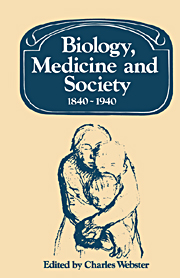Book contents
- Frontmatter
- Contents
- Contributors
- Preface and Acknowledgements
- Introduction
- 1 Women's Health and the Women's Movement in Britain: 1840–1940
- 2 Working-Class Mothers and Infant Mortality in England, 1895–1914
- 3 Theories of the Cell State in Imperial Germany
- 4 Innate Character in Animals and Man: A Perspective on the Origins of Ethology
- 5 Genetics in the United States and Great Britain 1890–1930: A Review with Speculations
- 6 Eugenics and Class
- 7 Sociobiologies in Competition: The Biometrician–Mendelian Debate
- 8 Psychologists and Class
- 9 Measuring Intelligence: English Local Education Authorities and Mental Testing 1919–1939
- Index
4 - Innate Character in Animals and Man: A Perspective on the Origins of Ethology
Published online by Cambridge University Press: 02 December 2009
- Frontmatter
- Contents
- Contributors
- Preface and Acknowledgements
- Introduction
- 1 Women's Health and the Women's Movement in Britain: 1840–1940
- 2 Working-Class Mothers and Infant Mortality in England, 1895–1914
- 3 Theories of the Cell State in Imperial Germany
- 4 Innate Character in Animals and Man: A Perspective on the Origins of Ethology
- 5 Genetics in the United States and Great Britain 1890–1930: A Review with Speculations
- 6 Eugenics and Class
- 7 Sociobiologies in Competition: The Biometrician–Mendelian Debate
- 8 Psychologists and Class
- 9 Measuring Intelligence: English Local Education Authorities and Mental Testing 1919–1939
- Index
Summary
I should like to have the complete biography of every animal.
C. G. LeroyIn the aftermath of a scientific controversy which has bordered at times on the outrageous, it is appropriate that historians should turn their attention to ‘The Roots of Sociobiology’. Of course, this is no easy task. For one thing, it is too early to be sure of the precise nature of the subject with which we are dealing. The biologist Richard Dawkins highlighted this problem recently, when he asked almost despairingly: ‘What on earth is sociobiology?’ According to the philosopher David Hull, this question cannot be answered in terms of a set of simple defining characteristics, or even by exclusive reference to the substantive content of the subject. Sociobiology, Hull argues, has no ‘essence’; in the last analysis it is what its practitioners make it. This approach introduces another element of uncertainty, since at the present time it is far from clear exactly who are the sociobiologists. When Edward Wilson published his massive volume Sociobiology. The New Synthesis in 1975, some biologists were surprised that so much fuss should be made over a subject which they had been teaching in undergraduate courses for several years, and others wondered whether they were not witnessing a ‘political game’ involving the naming and renaming of fields. Finally, the problems facing the historian are compounded by the fact that the sociobiology debate is highly polarized, and the literature abounds with tendentious and superficial historical judgements. At close range it is often difficult either to ignore these judgements altogether, or to bring them into the sharp focus which is necessary for the purpose of critical assessment.
- Type
- Chapter
- Information
- Biology, Medicine and Society 1840–1940 , pp. 157 - 192Publisher: Cambridge University PressPrint publication year: 1981
- 17
- Cited by



